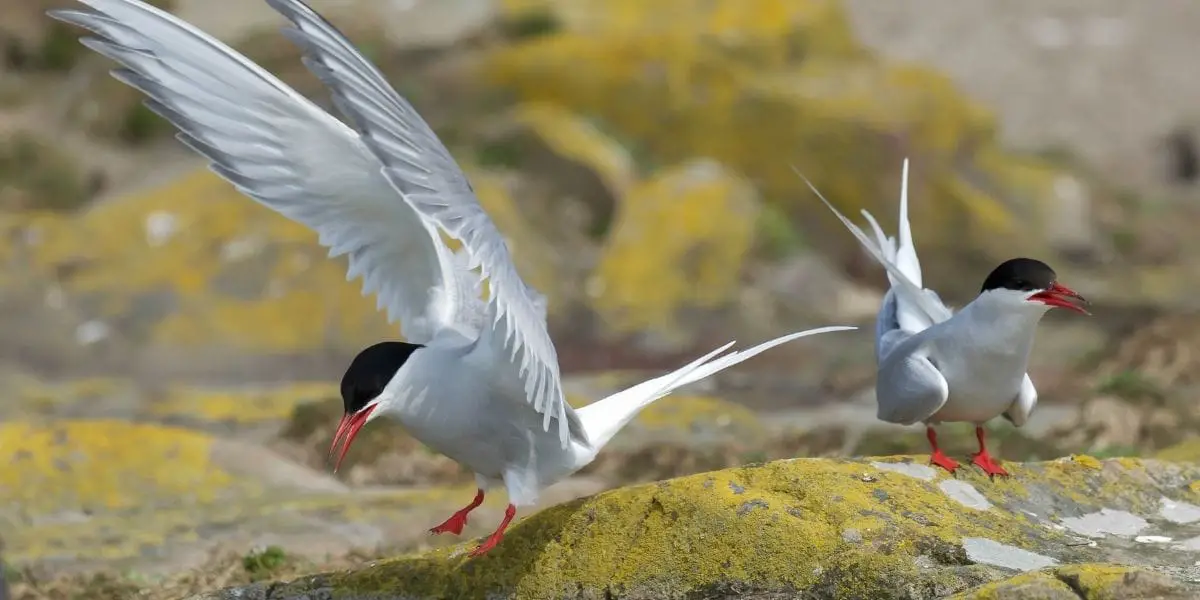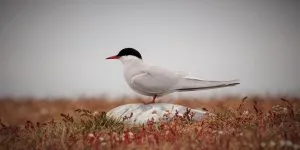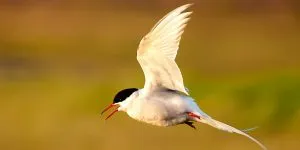Arctic terns are a remarkably resourceful species of bird. They have a widespread global distribution and require enough nutrients and energy to fly across the globe each year. With this in mind, maintaining a healthy, substantial diet is of great importance to the arctic tern, so what exactly do they eat?
The arctic terns’ palate is described as varied and opportunistic. This helps them stay healthy and energized for migration each year. Their diet consists of mainly fish and crustaceans but can also eat insects, mollusks, and berries if fish are not in abundance.
Keep reading to find out more about the screaming ‘fish flight’ exhibited by male birds and how some arctic terns resort to thievery to get the food they want!
Are Arctic Terns Carnivores or Omnivores?
An arctic terns’ diet consists mainly of fish, crustaceans, and insects so they are generally classified as a carnivore (or a piscivore). They are opportunistic and occasionally eat berries or other plants too, however, this is only a tiny part of their diet so we would not call the arctic tern an omnivore.
What Do Arctic Terns Eat?
Arctic terns mostly eat fish as their main food source, however, they are opportunistic and are also known to feed on krill, crabs, mollusks, insects, and even berries. Let’s look at each of these in turn;
Fish
Arctic terns like to prey on small, schooling fish found close to the ocean surface. This includes cod, smelt, sand lances, herring, and sand eels.
They prey on more immature fish which are easier for the arctic terns to chew and swallow. This is especially essential when the arctic terns are in the midst of migration and do not want to waste energy on catching and eating larger fish. In fact, during their migration to Antarctica, they almost exclusively eat fish.
The habitat of the arctic terns is often dictated by fish populations. They will nest close to the coast where there are abundant populations of fish to prey on. Check out our dedicated article if you’d like to know more about where the arctic tern lives.
To catch their prey they will swoop and dive into the water at high speeds to grab fish swimming near the surface with their beaks or feet. Sometimes they will pierce the prey’s body for an even better grip1 (source: National Geographic).
Arctic Terns can only catch fish as deep as 50cm below the surface of the water2 (source: J.M. Morten, et al., Frontiers in Marine Science, Vol. 8, 2022), this might sound deep but it’s not even a scratch on the deepest dive by a flying bird recorded at 210m3 (source: Guinness World Records).
Krill
Krill is a small crustacean with widespread geographic distribution therefore it can be utilized by the arctic tern across many different regions and habitats.
Krill has high-fat content, therefore, is vital for arctic terns’ migration. Fat is a very energy-dense substrate that can be metabolized slowly throughout its journey to sustain flight over large distances.
See our full article to find out more about the arctic terns’ migration.
Crabs
Crabs are crustaceans that are easily caught and eaten by the arctic terns. Arctic terns’ habitats tend to gravitate towards coastal regions, therefore there are often large quantities of crabs on the sand to be snatched up by the birds.
The arctic terns will smash crabs’ bodies against hard objects such as large rocks. This kills the crab instantly preventing escape and allowing the arctic tern access to the meat inside the crab.
From a nutritional point of view, crabs are a beneficial addition to the arctic terns’ diet. They provide high levels of zinc, copper, and Vitamin B2 for the birds ensuring healthy individuals.
Mollusks
Mollusks tend to be found in aquatic habitats such as those inhabited by arctic terns, therefore these easy-to-find creatures are preyed upon by the bird. For harder-to-find mollusks that have become camouflaged with their surroundings, arctic terns will use their beaks to poke around rocks and sand to find them.
The arctic terns will use their beaks to puncture the mollusks’ shells to eat their flesh.
Insects
Insects are not the main source of food for the arctic terns but are used as snacks during the northern summer season when insect populations are in abundance. The birds snatch and grasp with their beaks at insects floating on the surface of bodies of water such as lakes, rivers, or oceans.
Berries
Arctic terns will normally feast on berries when nesting in the northern hemisphere during mating season. This is because they do not wish to leave the nest and their eggs for too long and need a meal that does not require expansion of time and energy. Thus high vitamin and high energy content berries are chosen to sustain the arctic terns.
How Do Arctic Terns Catch Their Food?
The arctic terns’ feeding habits are opportunistic. If they cannot find fish and crustaceans in readily available numbers, they will quickly turn to berries, insects, and mollusks to get the nutrients and energy they need.
Their behavior of catching prey can depend on the season:
- During mating season in the summer, the male arctic terns will exhibit what is termed the ‘fish flight’ in which they catch a fish in their beak and fly about screeching. After this, the male will land in front of a female tern and offer them the caught fish. If the female is satisfied, they will breed.
- During nesting season in the summer, they are stationed in one spot (the nest) and will exhibit more foraging behavior for berries or terrestrial insects nearby. This ensures the birds do not leave their eggs vulnerable to predation for too long, in search of food.
- Throughout their migration, their feeding behavior consists of swooping and diving down to the ocean surface to pluck small fish out of the water and then continue flying. This ensures the migration can continue with fewer stops.
The arctic terns also exhibit kleptoparasitism. Kleptoparasitism is when an animal steals resources from another animal, for example, food. The arctic terns often startle other birds, such as common terns, and auks, into abandoning or dropping their food. After which the arctic terns will steal it for themselves.



![Read more about the article How Big Is The Arctic Tern [Size + Weight Compared]](https://polarguidebook.com/wp-content/uploads/2022/04/How-big-are-arctic-terns-300x150.jpg)

